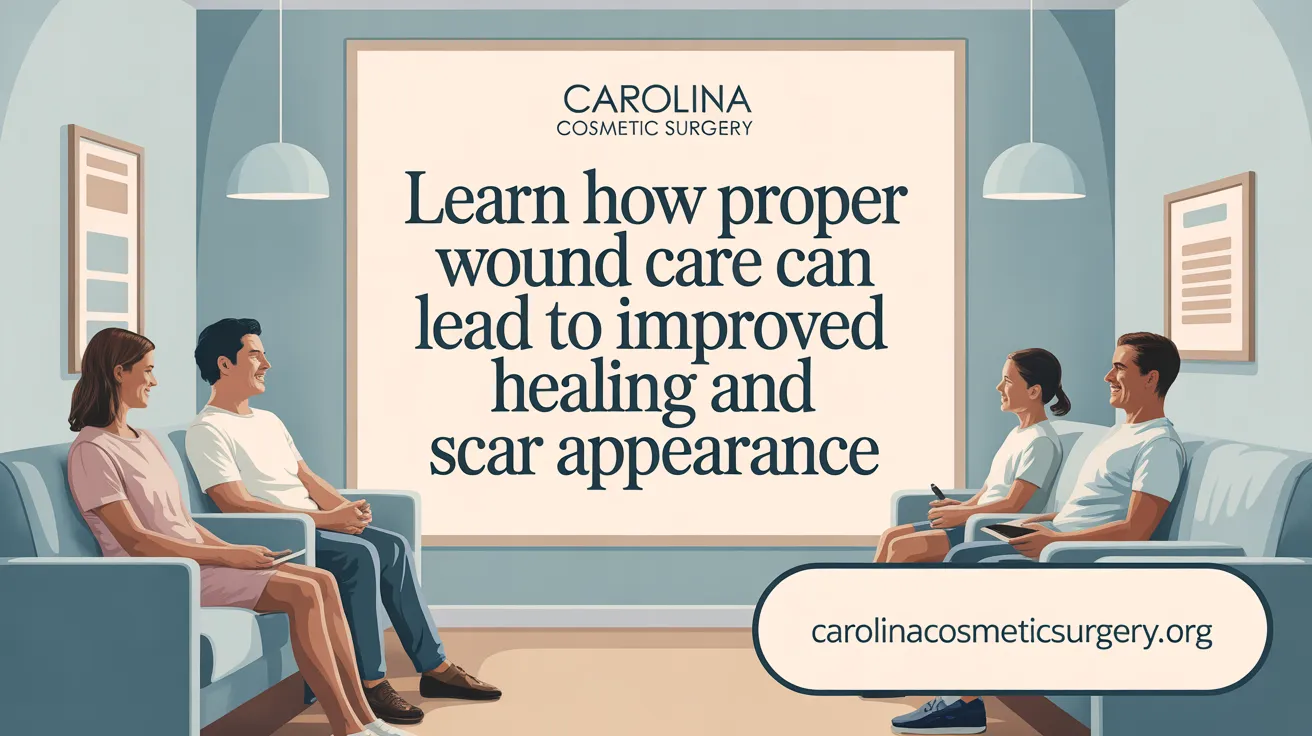Understanding Scar Formation and Management
Scarring after cosmetic surgery is an inevitable part of the healing process, but with the right care and techniques, its appearance can be significantly minimized. This article explores the biological basis of scar formation, factors influencing healing, effective post-operative wound care, natural and medical scar treatments, and expert surgical strategies to ensure the best possible outcomes for patients.
<!-- VIDEO:eyJsaW5rIjoiaHR0cHM6Ly93d3cueW91dHViZS5jb20vd2F0Y2g/dj0zVEN1Tjg0M191WSIsImltYWdlVXJsIjoiZGF0YTppbWFnZS9qcGVnO2Jhc2U2NCwvOWovNEFBUVNrWkpSZ0FCQVFBQUFRQUJBQUQvMndDRUFBa0dCd2dIQmdrSUJ3Z0tDZ2tMRFJZUERRd01EUnNVRlJBV0lCMGlJaUFkSHg4a0tEUXNKQ1l4Sng4ZkxUMHRNVFUzT2pvNkl5cy9SRDg0UXpRNU9qY0JDZ29LRFF3TkdnOFBHamNsSHlVM056YzNOemMzTnpjM056YzNOemMzTnpjM056YzNOemMzTnpjM056YzNOemMzTnpjM056YzNOemMzTnpjM056YzNOLy9BQUJFSUFGTUFsQU1CSWdBQ0VRRURFUUgveEFBY0FBQUNBZ01CQVFBQUFBQUFBQUFBQUFBRkJnQUVBUU1IQWdqL3hBQkdFQUFDQVFNQ0F3UUdCUWdHQ3dBQUFBQUJBZ01BQkJFRklRWVNNUk5CVVdFaU1sSnhrYkVIRklHaHdTTXpRbVNTb3JMUkZTVnljNVBoRmlRMU5rTkVZbU9Dd3ZEL3hBQVpBUUFEQVFFQkFBQUFBQUFBQUFBQUFBQUJBZ01BQkFYL3hBQXBFUUFDQWdFRUFRSUZCUUFBQUFBQUFBQUFBUUlSQXdRU01VRWhNbEVGSXpOeGdSTWlOR0h3LzlvQURBTUJBQUlSQXhFQVB3Qjd1cmJ5b0plMnBHU0JSRGh2WHY2ZmluRDJ3aW1nQzgvS2NxMmM5TzhkTy80MVp1NE1nN1ZCTzBkV1RITEhKeGx5SmQxSDEyb1BjSVZibVRyNGVOTk9wV3hVazQyb0JkTHVhS1pNcXd6NUd4NlZiam1QalZTR0RERTljNzFkaWhHT2xOdUZNTlBMR2NwdnpkMksySmR6K3grNmEycEY0QVZzV0VudW83aGFOWXU1dlpIN0pxekRLZXpYZnVGUllQRWZkV3dXNDlrZkNzNUJveDJ2blhrejVPTStacjBiY2V5UGhYazI0OWtmQ3R1TlJudDhkOWEydWNEYzFob0I3SStGYW5oSHNqNFVOd1NQT1R1VzNxdExPU2NLY212VHdEMlJYbU9JS1R0VzNCU0pGRVNjdHVhSldzV1RpdEVLVXdhUFpjeERNS0ZqVWU0ZFBab3dTS2xNOFZxQkdOdm5Vb1dhaE4rakdJc21wdjV4QWZ2MDEzTVZMbjBYTC9WK29ONHpLdndYL09teTRHUlVvZWs3ZmlIOG1YKzZGclVvQVZPMUtHb29VY2luMitRRUdrN1dZZlcycWlPRmlQeFZxMTdwaHNoWnlCQklybHNxRG5HTWRmZlFWZUxOYVgvbUUvd2xvangyZ054cFNzY0FvK1Q0YnJTb09sVlM4RXhnWGpIV3gwdUkvd0RDV3Q2YS9yR29rSzR1SmdQUnhiK2dDZlBINDB1d3h0STZvbTdzd1ZSNWsxMExScjZHd2hTMi9vNmY2dXV4bUdNKy9IV2pYc05HTjhzRFFhanhKRGNDSzF0NUF5ajFkMno1bnVwbDRhNGl1amVuVGVJRWVLN2QxV0lOR0YzUGNjVVN1Nyt3c1VSNVowakRBTm5HNXBkNGl1NExxODB2VkxXVlptaHZJL1RIVmdXR3g4NjB2c05MR29xMHpvSmo4cTFORjVVVGEyT2NWcmUyTlNzbWdVOGRhSkk2S3ZiNHBVMS9pT0t4bGt0cldJeXpvY016N0t2NG1zTVhaUXFqTEVBZUpOYU8waXp0SW43UXBGMUc4dWI1eTkzSzBuZ0QwSHVGVlFxNDZDalF5T3E2Y3NUdUNaRS9hRk4ybTlrTVlkUHNZVjg5T3FkNnI4S3paOGtWN2J5QlFDa3FNQ0Iwd1FhMjBhejZoVWdBVkswZzdiZEtsSU1LdjBYci9VdDIzamRZL2NYK2RNODNmUzU5RjY0NGNtUGpkdjhBd3FLWnBoMW9KVXFMYXVhbm5sSkFpOEd4cFgxWk90TmQyTmpTM3FhNXpSUnlzNWY5SlNjaytsRHhoZjVpbENuWDZWRjViclNSK3JzZnZGSlFGWGp3VDdHZmhMVHJXNVQ2M0x1OFU0SHJIWVk4T2xOc21rV3FGSlNjYzdCUVdjRE9UU053dGRtQzdlREE1SlFDYzlRVjZZK0pwd3VKbmtNU2lQdFV4dHZnZkkxa20yZE1ISGJ3V3RVdG51cnVkclIxakFDcWhYRExnYmZnYTM4TzhJUjNMUlhXcHltTEYxRXlSUVI1N1JsT1J6ZUFQVCtWVmVIZ0pyOHd4eE5ER1cvSzdEN3NiVTYzV21hbmNXVFdtbnNiWUZPMjV6MFlnK2dudUpHNW83ZkZNTDJ2eXdKeGh4QnIxcHhOYTZUb0tXekc0dDFkVWxpeXpQelBrWkxBRFplK2dtczhRY2M2UFltODFDQ3dpaHp5aGhHalpiQk9QUmtQZ2FZdE10MTFlLzAvVnJqbGh2OEFUWitTZFQ2M0xnZ2crV1RrZUcvaWE4ZlM4by8wUVk0QS93QlpIVCt5MVRhcDBTY0VoaWhRejI4VWpkV1JTZmhYSXVKRks2dGZlUGJOWFpkTlhtMDYxUGpDbnlGY2g0clhsMWkrMjZTdFFSTVhHZGlUbnBXUzIxWWs3NjFzZHFZZEhpUnpVamNnRmozYjE0YzFFM1J4NUdtNk1mVkViYzBhTm5xb05ZclJwNzlwcDlxL3RRb2Z1RllxRkZBTjlHb0E0WFZoK2xjU0g3OGZoVERNYVh2bzN5T0VMVW5HV2tsSngvZU5SNlp0Nlp2YzdEbWk0emNYMFVMczdHbDNVQnVhUDNUYkdnbHhGMnpsZVpWR2NFbnVyY0V2TE9aZlMyT1cvd0JKSDZvZm1LU0lra25sV0dDTjVKRzJWRVVzVDlncnZHdmNJNlZxOXphM3VwUE5KOVhoN05ZNDM1Vllaems5L3dCOURSQlk2V3NsdnBsaERaeGdEMDQvV2syMzVqMSsrbVUxVkkzNlQ3RnJoSGhpT08wdlRmUloxTjRTWUZKMml4Zy90SHA5dVBHaXVuNkRMZDZkYjNEU3dtT1F0MmlOa05IZzRCODgxYjArY3BlZHNvSG9xUjlwb2xaNWFSbFZRV1BkdGdlZFd0T0tya2FFSHViNk5tbTJjRUVrY051UkZGRXZPemRTZk0wYjB1Q2U1dmZyd21LckdXaWFBU0hDOHBJd1Z4dWM1M3pRSnIrMXRidUh0RWFXSkpoMjd4akpKSFE0OWxmblJDMnZZNGRlMUQ2ck1qUk5Qem95dGxXRHFHLzlxT2ZITEZqVW11U2J5Unl6ZU5kQWZpbTZGanhITmMyeVBGTXZLSmw2ck1oQTlMMzkzMlZuWDRUeFJ3NituVzl3c2VmeXNMdVBSY2dFY3BQZDE2MHk2aGFhYnJ5WWxQSmN4YkxJRnlOLzBUNGp5cEQwdTRleHYzczdvbEl4SVFGejZyQTl4cWNISEtxWEtMY2NuUjlKaWROTHRFbFhsa1dCQXc4Q0ZHYTVGeG1tTmMxQURyMm40VjAvUk5VRHpOYVRZQi9RUGNhNXp4akcwbkUxN0hHTXN6akEvd0RFVXRVeUxWT2hMblJ4ekh1clZtcjEyUWJaMkhUa3pRa1RDbUNiaW9OWkM0QnJ3c29OZTgxakgwam9FM2FhRnB6NTlhMWpQN29xVlM0U2w1K0Y5SmI5VWovaEZTb2oyWjRBd3ZCOWhqdjdRL0dScUx6TnZRamdnY3ZDR21EL0FMUlB4WTBSbWJmclJYQStlVjVaUCsyQzlZdm9yS0lQTHpIbUpDaFI1RS9oU3RIZjRtY2x3OGNzd2RTTzdZakh5cS94UGNTeVhjVnZHU3F4NGtMaFNkOThaOFA4NkJ0WnUxeVdibGlSaUN5eG5JWnZGZmY0R3FKTHNSS3ZJYmUrSnRuQWtVY3BBeVd3TWs0QTM4U1FLQ0pGTmVNc1lVNVVZMjN6L3dEZU5OZkcrZ0luQ01Rc28veWxsS0xoMkhVbmtkQzUyMzVlY3NQZG4zMUxSZE8weXhoUzNaRlJZd0FSM2luV0gyRng1bzVMZlNCOXJaTXBDY3V5OTNkV3hpeU8wRmllYVZnZVp2WkZEOVIxK0ZTd2drWEhRQUhlaXVpMnBhUHRGM1p0eWUvcFhicGRPcFN0OElocXRTOGNmSFo2czlOTTBhREhLb0ZDUXYxSFVMMVIwU1ZTUGNWR2FkdE90aUF3SUlDN0RQZjMvalNuclNkbnJsNHVPb1grR3IvRUo3OGUzMm80dEEvbS9ndndYcWlOWDV0aFFqWDRSY1RDOXRseXd3WFZkemtkL3dBSzBCbS9OazdGdTZ0dmF0RmdxVFhpeGk0TzBleTNhb2tlcFJuczJCdytCZ2c5OUR1S0xlNWt1WDFpQUYxSUJsSUdlellER1NQQStOVTdvM01mNVp2UmlhUnljYjRBUHJIeThmZURSYXh2SklKN0xsazVrdUo0b2lEZzh5dXdVcjlvSkZkTGp1VmtuVHNRcndjdHJLbzdrUHlwZmd3OG5LeDJ4M1UrOFo2TWxnYnVTMC9OUnMwYzBZLzRUYjRQOWx1bytGSU5xY1RqM1ZQeW5URmZIZ0t4L1VvSVdTYTE3YVE0S3lwY0ZlWGJwakJ6VllUSXBJSHd6V0h4MmJZeFRWb3JqK2pyZnA2bE1oTE5XbjhiYTNZV2tkcmIzMGl3eEFMR3ZJaDVSNFpLNXFVWEQ3VksxSVBrNm53aC91bnBmOXdLdVhGU3BVVVh5ZXQvY1NvWjVXVitaMmJyNnh6MzFTWjJNaTVQZlVxVldIckRMMEhYUUFkaU1namNWODc4ZEZ0SjRzMUhUZE9kNExKWlZDd3F4NVZCVlNRTTlCa25wMDdxeFVycFhKNDJsZjdtZXJ4Rmp2WlVRWVZaR0FIZ00xMUxoTUEya1dSK2l2OEFEVXFWYlM4WkI5ZDZZakxFb0RIQXBDNHAyMStmSGd2eUZTcFU4M3BZbWcrcitBY2dIYXI3aitGWXVRTmhXS2xjclBYRjY0ZHJlOEx3c1VkWmNnanp6bjVVL3dDbDZmWk5EQmNtMGc3Wkg1MVlSZ1liQk9SV2FsZCtrU2VOMzdubmE1dE5VVXRjdExlNXVaQk5FcmR2RTBjbi9VdlhmK2ZkWENvZnorUENwVXJuMWErY3l1bitoRXN0NnBwbjBQOEEyZkQ3ajh6V2FsUlJSQlVkS3hVcVZoai8yUT09IiwidGl0bGUiOiJGYWNpYWwgUGxhc3RpYyBTdXJnZW9uIFJldmVhbHMgSG93IHRvIE1pbmltaXplIFNjYXJyaW5nIiwic25pcHBldCI6IjEpIERpcnR5IHdvdW5kcyBtdXN0IGJlIHRob3JvdWdobHkgaXJyaWdhdGVkIGFuZCBjbGVhbmVkIGFuZCBtYXkgcmVxdWlyZSBhbnRpYmlvdGljcyB0byBwcmV2ZW50IGluZmVjdGlvbi4gwrcgMikgSXQgaXMgYmV0dGVyIHRvIGJlIGV4YW1pbmVkIGFuZCAuLi4ifQ== -->Factors Influencing Scar Healing After Cosmetic Surgery

What factors influence the healing and scarring process after surgery?
Scar healing is a complex process affected by numerous interrelated factors. The characteristics of the wound itself, such as its size, depth, tension, and location, are major contributors. Larger and deeper incisions tend to be more prone to prominent scarring. Areas subject to high tension or movement can increase the risk of hypertrophic scars or widened wounds.
Patient-specific elements are equally important. Age impacts healing, with older patients often experiencing less prominent scars that tend to be flatter and paler, although healing may be slower. Skin type and genetic predispositions, such as a family history of keloids, substantially influence scar formation. Nutritional health, including adequate intake of protein, vitamins C and E, and minerals like zinc, supports optimal healing.
Lifestyle choices also play a vital role. Smoking restricts blood flow and delays wound healing, making scars more prominent. Excessive alcohol consumption and poor diet can impair tissue repair. Hormonal levels, especially during puberty or pregnancy, may accelerate or alter scar characteristics.
The risk of infection is a critical factor. Bacterial presence or wound contamination prolongs inflammation and tissue destruction, worsening scars. Proper postoperative care with infection prevention is essential.
Mechanical factors, such as how incisions are planned and executed, influence scar quality. Surgeons aim to place incisions within natural skin creases or hidden areas to minimize visibility. Using fine, resorbable sutures and techniques that reduce tissue trauma help promote smooth healing.
Finally, aftercare strategies like silicone gel or sheets, scar massage, avoiding tension, and protecting the area from sun exposure further shape the final appearance of scars. Overall, careful management of these physiological, individual, surgical, and environmental factors can lead to improved healing and more aesthetically pleasing results.
The Physiological Process of Scar Healing

What are the phases involved in the physiological process of scar healing?
Scar healing occurs in a sequence of well-coordinated stages, each vital for restoring skin integrity after an injury or surgical procedure.
The process begins with the inflammatory phase, which starts immediately upon injury. This phase typically lasts about 3 to 5 days and involves the stopping of bleeding, as blood vessels constrict to prevent further blood loss. Immune cells, such as macrophages and neutrophils, are activated to clear out bacteria, debris, and damaged tissue, leading to swelling, redness, and warmth around the wound.
Following this, the proliferative phase occurs, generally spanning from day 5 to day 15. During this period, new tissue begins to form as fibroblasts produce collagen to rebuild the injured area. New blood vessels form in a process called angiogenesis, providing necessary nutrients and oxygen to the healing tissue. Keratinocytes also migrate to cover the wound, creating a new epithelial layer. This stage is crucial for reducing the wound size and establishing a scaffold for further tissue repair.
Finally, the remodeling, or maturation, phase can last from several months up to a year. During this time, collagen fibers are reorganized and crosslinked, leading to a flatter, lighter, and more resilient scar. The tensile strength of the tissue increases, although scars rarely regain the full strength of uninjured skin. Adjustments and treatments during these stages, such as silicone sheets, scar massage, and laser therapy, can influence their effectiveness and the final scar appearance.
Throughout the entire healing process, various factors influence the speed and quality of recovery. These include the patient’s age, overall health, presence of chronic conditions like diabetes, wound care practices, and lifestyle choices. Adequate wound management and early intervention are essential for optimal scar formation, with more advanced therapies available for problematic or hypertrophic scars.
Optimal Post-Operative Wound Care for Scar Minimization

How should wounds be cared for post-operatively to reduce scar formation?
Proper wound care after surgery is essential for minimizing scars. Maintaining a moist environment by applying ointments such as petroleum jelly or silicone gel sheets encourages faster healing and improves scar appearance. Keeping the incision protected from sunlight with broad-spectrum SPF 30 sunscreen for at least 12-18 months helps prevent pigmentation darkening and structural changes.
Scar massage is another helpful technique. Starting about 2-3 weeks after the wound has closed, gentle massage with moisturizers like vitamin E or cocoa butter can break down fibrous tissue, making scars more flexible and less noticeable.
Using silicone gel sheets or tapes consistently over several months has proven benefits. These products help flatten hypertrophic scars and reduce redness. To prevent abnormal scars, especially in areas prone to tension, surgeons often employ meticulous suturing techniques, like deep fascial fixation or Z-plasty, to distribute tension evenly.
In cases where scars become raised or thick, additional treatments such as steroid injections or laser therapy can help improve their appearance. Following these guidelines diligently enhances healing and results in less prominent scars.
Timing and Natural Techniques in Scar Treatment

When to start scar treatment
The optimal time to begin scar management is after the wound has fully closed and healing appears complete. Usually, this occurs around 2 to 4 weeks after surgery. Before starting any treatment, the scar should show no signs of scabbing, oozing, or bleeding, and the skin should be sealed and smooth. Initiating treatments too early can disrupt the natural healing process, while delaying may lessen their effectiveness.
Once the wound has healed, gentle interventions like silicone gels or sheets can be introduced. Scar massage, which helps in reducing adhesions and softening tissue, is best started around four weeks after surgery, but only under guidance from a healthcare professional. It's advisable to consult with your surgeon or dermatologist about the most suitable timing and methods for your specific scar to achieve the best aesthetic outcome.
Natural remedies to support healing
Several natural approaches can complement medical scar management techniques. Applying Aloe Vera gel twice daily is renowned for its soothing and healing properties, potentially improving scar appearance over time. Light massage with natural oils such as rosehip seed oil, lavender oil, or coconut oil can promote blood flow, support tissue regeneration, and make scars appear less prominent.
Protecting scars from sun exposure is crucial. UV rays can darken scars, making them more noticeable and delaying healing. Using hats, clothing coverage, and applying broad-spectrum SPF 30+ sunscreen helps prevent pigmentation changes.
Additional natural options include honey, which has anti-inflammatory and healing properties. Applying a small amount overnight can soothe the area and support tissue repair. Maintaining good hydration by drinking plenty of water helps keep the skin elastic and healthy, creating an ideal environment for wound healing.
Role of hydration and nutrition
Proper hydration is vital for optimal wound healing, as water supports cellular functions and keeps the skin supple. Along with hydration, a balanced diet rich in proteins, vitamin C, E, zinc, and iron enhances collagen production and tissue repair, leading to less conspicuous scarring.
Foods high in these nutrients include citrus fruits, nuts, seeds, leafy greens, lean meats, and dairy products. Avoiding smoking and excessive alcohol intake is also recommended, as these can impair circulation and delay healing.
Sun protection strategies
Protecting your healing scar from sunlight is essential to prevent discoloration and long-term visibility. Use a high-SPF sunscreen diligently, especially during the first year after surgery. Wearing wide-brimmed hats, sunglasses, and protective clothing can further shield the area from UV damage.
Limiting sun exposure during peak hours and avoiding tanning beds helps reduce the risk of pigmentation changes and promotes clearer, smoother scar healing. Consistent sun protection can make a significant difference in the final appearance of your scar.
Advanced Medical Treatments and Technologies for Scar Reduction

What treatments and therapies are most effective for minimizing surgical scars?
Minimizing the appearance of surgical scars involves a combination of medical treatments and proper wound care. Silicone-based therapies, including sheets and gels like Strataderm or Mederma, are among the most effective for reducing scar thickness and improving elasticity. These products help keep the scar hydrated, soften the tissue, and promote a more favorable healing process.
Corticosteroid injections are widely used for thick, raised scars such as keloids or hypertrophic scars. They work by reducing inflammation and collagen buildup, leading to softer and flatter scars.
Laser and light-based treatments have advanced significantly. Fractional CO2 lasers and other resurfacing devices stimulate collagen production and remove superficial damaged skin layers, significantly improving texture and color. Vascular laser treatments can reduce redness, while skin bleaching techniques lighten skin tone for better scar concealment.
Surgical revision procedures are considered for large or problematic scars. Techniques such as scar excision, Z-plasty, or skin grafts can alter scar shape, release tightness, and reposition incisions in inconspicuous areas.
Complementary therapies include massage, which can break down excessive collagen, and sun protection, crucial for preventing hyperpigmentation. Using support garments, maintaining moisture, and avoiding tension on the scar are vital post-treatment steps.
| Treatment Type | Purpose | Additional Details |
|---|---|---|
| Silicone gel sheets or gels | Flatten and soften scars | Requires consistent use for several months |
| Corticosteroid injections | Reduce size and inflammation of raised scars | Often used for keloids and hypertrophic scars |
| Laser and light therapy | Improve texture, color, and overall appearance | Multiple sessions often needed |
| Surgical revision and fillers | Modify scar shape, improve function | Suitable for large, irregular, or problematic scars |
| Post-treatment care | Enhance healing, reduce pigmentation | Includes scar massage, sun protection, and moisture application |
Overall, the most effective strategies involve a multi-modal approach. Combining silicone therapy, laser treatments, and possibly surgical revisions with diligent postoperative scar management can substantially improve aesthetic outcomes.
Surgical Techniques and Lifestyle Choices to Optimize Scar Outcomes

Do scars from plastic surgery completely disappear over time?
Most scars from plastic surgery do not fully vanish but tend to become less noticeable as they heal and mature. The healing process can last from six months to two years, during which scars initially appear red, raised, and prominent before gradually softening and fading to a more subtle appearance.
Proper postoperative care plays a crucial role in this process. Regular scar massage, silicone gel sheets, and sun protection help improve the scar’s appearance over time. In some cases, laser therapy, microneedling, or laser resurfacing may be used to further reduce the visibility of scars.
A plastic surgeon skilled in incision placement and meticulous tissue handling can significantly influence scar outcomes. Incisions placed within natural skin folds or behind hairlines help camouflage the scar and make it less conspicuous.
Factors such as individual skin type, age, healing response, and adherence to ongoing scar care all affect final results. While most scars become less prominent with proper care, complete disappearance is unlikely, but their appearance can be optimized greatly.
How do surgeon expertise and incision placement influence scars?
A surgeon’s skill is vital in minimizing visible scarring. Using precise techniques, making incisions in inconspicuous locations, and ensuring minimal tissue trauma helps create cleaner, flatter scars.
Placing incisions along natural creases, inside hairlines, or in areas covered by clothing can conceal scars effectively.
Using fine, resorbable sutures, minimizing tension on the wound, and employing careful suturing techniques reduce the risk of keloids and hypertrophic scars.
Why are suturing methods important to reduce tension?
Tension on a wound can cause the scar to widen, become raised, or develop irregularities. Surgeons often choose fine, dissolvable sutures and ensure that incisions are closed with minimal tension.
Proper suturing allows for better healing and scar flattening. Techniques like subcuticular sutures and skin adhesives can further promote a smooth scar surface.
How does lifestyle impact long-term healing and scarring?
Lifestyle factors significantly influence scar quality. Ceasing smoking at least four weeks before and after surgery improves blood flow and oxygen delivery to tissues, aiding faster healing.
A diet rich in protein, zinc, vitamin C, and iron supports collagen production, essential for wound healing.
Staying well-hydrated and maintaining a healthy weight reduce strain on healing tissues.
Protecting scars from sun exposure with SPF 30+ sunscreen, hats, and clothing prevents hyperpigmentation and worsened scar coloration.
What are long-term scar management strategies?
Consistent scar care includes regular massage, silicone gel application, and sun protection for up to a year.
Scar massage, starting a few weeks after wound closure, can help degrade excess collagen and improve flexibility.
Silicone sheets and gels help flatten and soften scars, especially hypertrophic or keloid types.
Follow-up visits with your surgeon are essential to monitor healing and decide if additional treatments like laser therapy or steroid injections are necessary.
Maintaining a healthy lifestyle, avoiding activities that stress or strain the scar, and protecting it from sun damage are vital for reducing long-term scar visibility.
| Aspect | Best Practices | Additional Tips |
|---|---|---|
| Incision Placement | Concealed in natural folds or behind hairlines | Plan preoperatively with your surgeon |
| Suturing | Use fine, dissolvable sutures to reduce tension | Avoid excess tension post-surgery |
| Lifestyle | Quit smoking, eat protein-rich foods, stay hydrated | Avoid strenuous activities early on |
| Scar Management | Massage, silicone gels, sun protection | Continue for up to 12 months |
Final Thoughts on Minimizing Cosmetic Surgery Scars
While scars are an unavoidable part of cosmetic surgical procedures, they do not have to define the aesthetic outcome. Understanding the complex healing process, choosing a skilled surgeon, adhering to rigorous postoperative care, timely intervention, and employing both natural and advanced therapies can dramatically improve the appearance of scars. Maintaining a healthy lifestyle, protecting scars from sunlight, and committing to long-term management help ensure that scars fade and integrate smoothly with the surrounding skin. With these comprehensive strategies, patients can achieve the best possible results and enjoy renewed confidence post-surgery.
References
- Scar Treatment 101: What are the first steps? | ASPS
- Surgical Scarring: How to Minimize Scars After Surgery
- How Does a Plastic Surgeon Minimize Scarring? - Atlanta
- Update on Postsurgical Scar Management - PMC
- Scar Management After Plastic Surgery
- Worried about surgery scars? Here are some tips | ASPS
- How to Prevent or Minimize Surgery Scars - Verywell Health
- How Can Plastic Surgeons Help With Scarring?
- How To Minimize The Appearance Of Facelift Scars
